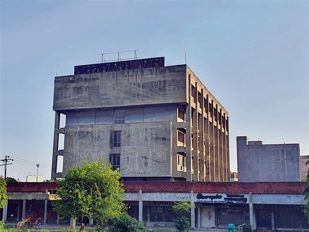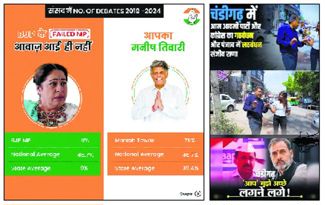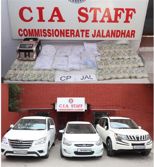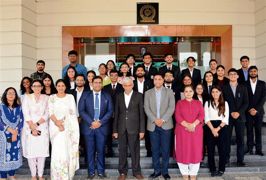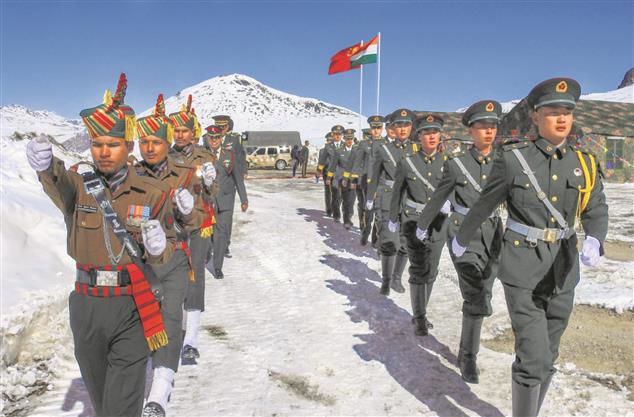
Deja vu: Indian mandarins and China watchers are no strangers to Beijing’s penchant for diplomatic duplicity and geopolitical intransigence. PTI
C Uday Bhaskar
Director, Society for Policy Studies
Discourse and narrative are critical elements in the shaping of the national security perception and related policy. Governments, whether liberal democracies or authoritarian regimes, accord considerable attention to these two strands in the evolution of national posture and policies. Both the US and China are examples of this practice.
China remains the abiding and heightened security and strategic challenge for India after the 2020 Galwan ‘shock’ administered by the PLA (People’s Liberation Army). It is instructive how this issue is being packaged in India in the run-up to the General Election.
In a recent interview with a US news magazine, Newsweek, PM Modi made a cautiously worded response to a question about the India-China border standoff. He noted: “For India, the relationship with China is important and significant. It is my belief that we need to urgently address the prolonged situation on our borders so that the abnormality in our bilateral interactions can be put behind us. Stable and peaceful relations between India and China are important for not just our two countries but the entire region and the world. I hope and believe that through positive and constructive bilateral engagement at the diplomatic and military levels, we will be able to restore and sustain peace and tranquillity in our borders.”
The operative phrases here are the reference to ‘abnormality’ in bilateral relations and the need to “urgently address the prolonged situation on our borders”. This response by the PM did not go into any operational detail, and the conciliatory tenor may be seen as a signal for what could be a more definitive China policy during PM Modi’s potential third term.
When the Galwan incident took place in the summer of 2020 and India lost a colonel (the CO of the battalion) and 20 other personnel, the PM’s initial assertion was that “no one has intruded into our territory”. This statement was later clarified by the PMO in a less than transparent manner — and it was evident that the dominant narrative at the time was to obfuscate the issue. Both India and China have kept the details about what transpired at Galwan under wraps and much of what is deliberated upon is based largely on conjecture.
On the Indian side, no substantive debate took place on this issue in Parliament. Over the past four years, Galwan has remained on the national back burner. Domain experts have been quoted on the subject and there is a guarded consensus that India has forfeited patrolling rights in certain areas of that part of the Ladakh region.
In recent months, External Affairs Minister (EAM) S Jaishankar, to his credit, has placed the Galwan issue in an appropriate perspective. Speaking in late March to the Indian diaspora in Malaysia, the EAM noted: “The India-China relationship is difficult. For reasons which are still not clear to us, the boundary agreements were broken by China in 2020. We actually had violence and bloodshed.” The onus for restoring normalcy at the LAC (Line of Actual Control) has been placed on China, even as numerous rounds of talks have not led to a resolution of the stalemate.
Against this backdrop, Home Minister Amit Shah also weighed in on the China challenge in an election rally in Assam on April 9 and accused then PM Nehru of ‘abandoning’ Assam in October 1962. This kind of vitriol is par for the course in election rallies and the BJP has consistently pilloried the Congress for the China debacle. Shah also asserted that China could not encroach upon a ‘single inch’ of Indian land during Modi’s rule.
While this may be seen as a case of projecting the Modi government as being more effective in safeguarding India’s sovereignty and territorial integrity, this is counterfactual and also at variance with what PM Modi and the EAM have maintained regarding the Galwan disruption to normalcy in the India-China bilateral relationship.
Adherence to an appropriate narrative template regarding sensitive national security matters by top ministers is the normative practice, and this has been particularly relevant in relation to China and the nuclear issue since the days of then PM Indira Gandhi.
When India conducted the Shakti nuclear tests in May 1998 under PM Vajpayee’s stewardship, some BJP leaders referred to this nascent nuclear weapon capability as a ‘Hindu bomb’. This characterisation was counter-productive to the Vajpayee projection that the Indian nuclear capability was anchored in NFU (no first use) and the principles of pristine deterrence, and a religious tag was undesirable.
This matter was relayed to then NSA Brajesh Mishra. Despite the enormity of dealing with the fallout of May 11, 1998, the PMO was able to issue a quiet directive to avoid religious terminology, and this was complied with by the principal actors at the time.
Amid the current election campaigning, there is a compelling case for evolving a narrative template in relation to the Galwan incident. The CCS (Cabinet Committee on Security) would be the appropriate forum for the purpose. In the prevailing environment, Galwan has become a bitterly contested issue between the BJP and the Congress and many intemperate statements are being made in an acrimonious manner. This is undesirable and will vitiate an already tangled bilateral dispute.
China has identified media warfare as one of the Three Principles of Warfare in its composite security strategy and has accorded this element high priority in its domestic and external information campaigns. In June 2020, the Chinese information ecosystem exploited PM Modi’s initial statement about ‘no intrusion’ to the hilt and sought to project the PLA as the victim of Indian perfidy in Galwan.
Indian mandarins and China watchers are no strangers to Beijing’s penchant for diplomatic duplicity and geopolitical intransigence. This goes back to the Nehru-Mao-Zhou Enlai era. There are many lessons from the Nehru-Krishna Menon handling of the information and narrative domain in the run-up to the October 1962 debacle that Modi’s team can benefit from while addressing China in this bitterly animated poll season.
As Admiral Arun Prakash, former naval chief, has cautioned, “Sacrificing clarity and a cohesive approach in foreign policy on the altar of domestic politics could cost India dear.”
Join Whatsapp Channel of The Tribune for latest updates.






















